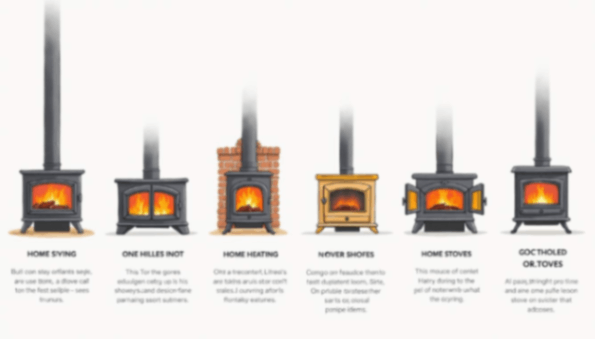In recent years, the trend of installing stoves in residential spaces has witnessed significant growth. With a myriad of benefits ranging from enhanced cooking experiences to aesthetic improvements, many homeowners are looking to invest in a stove. This article delves into the fundamental aspects of home stoves, their myriad advantages, installation processes, maintenance considerations, and guidance for making an informed decision.
Understanding the Basics of Home Stoves
Stoves come in various designs and functionalities, serving as essential appliances in kitchens and living rooms alike. As a central element of many homes, they not only provide heat but also offer a platform for cooking a diverse range of meals. The evolution of stove technology has significantly transformed the way we prepare food, making it easier and more efficient than ever before. From traditional cooking methods to modern innovations, stoves have adapted to meet the changing needs of households.

Different Types of Stoves
Home stoves can be categorized into several types, each with distinct features and advantages. The most common types include:
- Gas Stoves: Known for their quick heating capabilities and precise temperature control, gas stoves are favored by many professional chefs for their responsiveness.
- Electric Stoves: Offering ease of use and consistent heating, electric stoves are suitable for a variety of cooking styles, including simmering, boiling, and frying.
- Wood-Burning Stoves: Great for those seeking to add rustic charm while benefiting from renewable energy sources, these stoves can also serve as a primary heat source during colder months.
- Pellet Stoves: Efficient and environmentally friendly, burning compressed wood pellets for heat, these stoves are increasingly popular among eco-conscious consumers.
Understanding these types can help homeowners select the most appropriate model for their needs, considering factors like utility availability and personal cooking habits. Additionally, the choice of stove can influence the overall aesthetic of a kitchen, with various designs available to complement different interior styles. For instance, a sleek, modern electric stove may suit a contemporary kitchen, while a classic wood-burning stove can enhance a rustic or farmhouse ambiance.
Key Components of a Stove
Regardless of the type, several key components are common in most stoves. These include:
- Burners: Where the cooking heat is generated, with varying sizes for different pot and pan options, allowing for flexibility in meal preparation.
- Oven: The enclosed cooking space for baking, roasting, and more, often featuring multiple racks and settings for diverse culinary tasks.
- Controls: The interface for adjusting temperature and settings, crucial for cooking precision, which can range from simple knobs to advanced digital displays with programmable features.
- Exhaust System: Important for removing smoke and odors, especially in gas and wood-burning models, ensuring a comfortable cooking environment.
Familiarity with these components can aid owners in maximizing their stove's functionalities, enhancing their overall cooking experience. Moreover, understanding maintenance needs, such as regular cleaning of burners and ensuring proper ventilation, can prolong the life of the stove and improve its efficiency. As culinary enthusiasts experiment with various cooking techniques, knowing how to leverage each component effectively can elevate their culinary creations, making the kitchen a hub of creativity and flavor exploration.
The Advantages of Having a Home Stove
The benefits of installing a stove extend beyond mere cooking capabilities. Stoves can significantly improve a home’s environment and save on energy costs.

Enhancing Home Aesthetics
Stoves can serve as a focal point in kitchen design and add a distinctive character to a home. From sleek modern designs to classic rustic styles, a stove can complement the overall décor of your kitchen and enhance the aesthetic appeal of your living space.
Additionally, many stoves offer customizable options such as color, material, and design, allowing homeowners to select models that best fit their unique style. The choice of a stove can also reflect personal taste, whether it’s a vintage cast-iron model that evokes nostalgia or a contemporary stainless-steel unit that embodies minimalism. This versatility means that homeowners can create a cohesive look that ties together various elements of their kitchen, making it not just a place for cooking, but a vibrant part of the home’s identity.
Improving Cooking Experience
Having a dedicated stove enhances the cooking experience by providing an optimized space for meal preparation. The variety of cooking methods available through different types of stoves ensures that any dish can be prepared to perfection.
The immediacy of a heat source such as gas enhances the fun and interactivity of cooking for both home chefs and families, making mealtime an enjoyable occasion rather than a chore. Furthermore, many modern stoves come equipped with advanced features like smart technology, allowing users to control cooking settings remotely or receive notifications when meals are ready. This not only streamlines the cooking process but also encourages creativity in the kitchen, as users can experiment with new recipes and techniques without the fear of overcooking or burning their food.
Energy Efficiency and Cost Savings
Modern stoves are designed with energy efficiency in mind, helping homeowners save on utility bills. For instance, gas stoves often provide faster cooking times compared to electric models.
Furthermore, utilizing renewable energy sources, such as wood or pellets, can reduce overall heating costs and provide a sense of sustainability in your home. Over time, the savings from reduced energy consumption can offset the initial installation costs significantly. In addition to financial savings, energy-efficient stoves contribute to a reduced carbon footprint, making them an environmentally friendly choice. Many models now feature energy-saving settings that optimize fuel use, allowing for a more sustainable cooking experience while still delivering high performance. This means that not only do homeowners benefit from lower bills, but they also play a part in promoting a greener planet, making their cooking habits more responsible and aligned with contemporary environmental values.
The Installation Process of a Stove
Installing a stove is a crucial step, requiring careful planning and execution to ensure safety and functionality. Homeowners should take the necessary steps to prepare for this process adequately.
Preparing for Stove Installation
Before installation, homeowners should assess the area where the stove is to be placed. This includes evaluating dimensions, clearance from combustibles, and ensuring proper ventilation in case of gas or wood-burning units. It's also wise to consider the proximity to other appliances and the overall kitchen layout, as this can affect workflow and accessibility.
Considerations about the stove's fuel source are paramount; homeowners should ensure access to gas lines or proper space for ventilation if planning to install an electric or wood-burning model. Additionally, understanding local building codes and regulations is essential, as these can dictate specific requirements for stove installation, especially concerning safety measures and clearance distances.
Step-by-step Installation Guide
- Select the appropriate location with adequate space and ventilation.
- Ensure any necessary permits or inspections are completed prior to installation.
- If using gas, have a professional plumber connect the unit securely.
- For electric stoves, ensure proper electrical connections are made in accordance with safety regulations.
- Test the stove thoroughly after installation to confirm all components are functioning correctly.
Following these steps will help ensure a smooth installation and safe operation of the stove upon completion. It is also advisable to read the manufacturer’s installation manual thoroughly, as it often contains specific instructions and safety warnings that are unique to the model being installed. Furthermore, homeowners should consider the aesthetic aspects of the installation, such as the alignment of the stove with countertops and cabinetry, which can enhance the overall appearance of the kitchen.
After installation, regular maintenance is key to ensuring the stove operates efficiently and safely. Homeowners should familiarize themselves with the cleaning requirements and recommended service intervals, which can vary depending on the type of stove. For instance, gas stoves may require periodic checks of the burners and gas lines, while electric stoves might need inspections of the wiring and heating elements. Keeping a schedule for these maintenance tasks can prolong the life of the stove and prevent potential hazards.
Maintenance and Safety Tips for Your Stove
Once a stove is installed, ongoing maintenance and safety measures are essential for longevity and functionality.
Regular Cleaning and Upkeep
Cleaning the stove regularly promotes efficiency and ensures safety. Spills should be wiped up immediately to prevent buildup, and burners should be unclogged to maintain optimal performance.
Additionally, periodic professional inspections can help identify potential issues before they develop into costly repairs.
Safety Measures to Consider
Ensuring safety while using a stove is vital. For gas stoves, install carbon monoxide detectors in the home to monitor air quality.
Furthermore, ensure that all manufacturer and safety guidelines are strictly followed, and educate your family on stove usage to mitigate risks.
Making the Decision: Is a Stove Right for Your Home?
Ultimately, deciding whether to install a stove depends on several personal factors, including lifestyle and cooking preferences. Assessing your home’s suitability and needs is critical.

Assessing Your Home's Suitability for a Stove
Considerations like available space, design compatibility, and utility access will influence this decision. For instance, certain stoves may not be suitable for smaller kitchens due to size considerations or lack of required ventilation.
Also, think about the intended use of the stove—whether it’s for occasional cooking or as a main heat source. Evaluating these aspects will guide you toward the right choice for your home.
Weighing the Pros and Cons
Before making a final decision, it is essential to consider both the advantages and potential downsides of stove installations. While the benefits frequently outweigh the cons, understanding what you might have to compromise on can help ensure you make an informed decision.
By conducting thorough research and reflecting on your family’s needs, you can confidently determine whether installing a stove is the right choice for your home.











